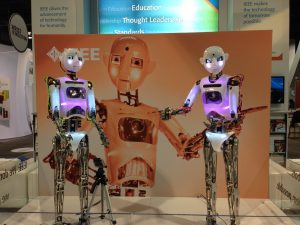Scores of technology PR pros hit the massive show floor at the 2014 International Consumer Electronics Show (CES) to support clients during interviews and engage with a vast army of bloggers, reporters and influential columnists that take over Vegas. For three days, more than 150,000 consumer technology – and increasingly enterprise technology – industry-types watched, tweeted and blogged about everything CES.
With all of the new, cool and trendy products for the media to ogle during CES, it can certainly be hard to keep up. And despite all of that product-focused hoopla, CES still managed to give us plenty of drama to report on this year. Amidst all of the chaos, there are both beneficial lessons and industry trends that PR pros can add to their client services toolkit.
Let’s start with Samsung. The company lit the twitterverse on fire with the news that famed Hollywood director Michael Bay had a diva-esque meltdown. After being on stage for less than three minutes, his performance came to a crashing halt thanks to a malfunctioning teleprompter during the company’s presentation for its 105-inch curved ultra-high-def television. Bay apologized hours later via his blog, calling his actions (including his abandoning a Samsung executive, presumably unable to ad-lib, on stage) embarrassing.
As PR professionals, we are challenged to expect the unexpected and to have back-up plans in place. Teleprompters fail and Wi-Fi gets dropped. What if someone spilled coffee on the laptop or there was an unanticipated power surge? While these aren’t things that we can control, we can and must support the client in their time of need.
When we manage events for clients, we know that sometimes making a chair available, jotting a few inconspicuous notes, supplying a podium, or even providing a graceful out, can turn a mistake into a cleverly executed maneuver that doesn’t distract from the topic at hand. From what I read, details about Samsung’s new 105-inch curved ultra-high-def television came as an afterthought, certainly not what the company wanted or expected.
Next, CES brought us the mobile wars. T-Mobile U.S. CEO John Legere, a Twitter fave who enjoys pushing the envelope with customers and press online, showed up at the AT&T party, only to be escorted out by security (Legere was said to be a huge fan of Macklemore who was performing at AT&T’s party). He then took to Twitter to poke fun at the incident, posting the photo used above, and even stopping to pose for a selfie with a CNET journalist on his way out.
While this may have been funny in the moment, trade shows are infamous for competitive spying. Competitors will register as press or bloggers to disguise their intentions and get closer access. I once managed the press room for a large industry trade show and had to turn away two “fauxporters” from the same competitor. This practice speaks to one of the ten commandments of PR: Anywhere reporters will be, there shall PR have a guiding hand. If press or analysts are invited to the evening entertainment at a trade show, the PR rep should have input into the guest list and recognize the competitors that lay in wait.
But ignoring Hollywood-style meltdowns, CEO hijinks and bendable screens, one of the other mind-blowing (but less widely reported) stories to come out of CES delved into the human brain. Intel talked about its theoretical chip designed to imitate the functions of the human brain manifest in its new message “make everything smart.” Intel previewed prototypes of this advanced chip in action with biometric earphones that can track your heart rate, and a coffee mug that doubles as a baby monitor. While Intel and other chipmakers are some time away from actually creating this little marvel, it got me thinking about the implications for this kind of technology for the vast universe of life sciences. While you may not look at CES as a show that impacts the life sciences, consider how journalists are covering technology products. Journos have an inner geek, a curiosity about why, how, and the potential future use of a product.
Life sciences, healthcare, and other industries certainly tap into these curiosities and creativity, so perhaps we’ll see these industries more heavily represented at trade shows like CES in the future?
With that in mind, PR pros can think about how their clients B2B technology product can tap into the “what if” and take their clients message to a wider audience. Many of the hot technologies we learned about at CES may have started out as part of a B2B technology or government solution.
Fitness technology, connected life/smart homes that will be a key part of the Internet of Things, wearable technology, and automotive technology all fit this thinking. Maybe you and your clients have a new story to tell…but how will you get that message heard? Share your thoughts with us in the comment section.


